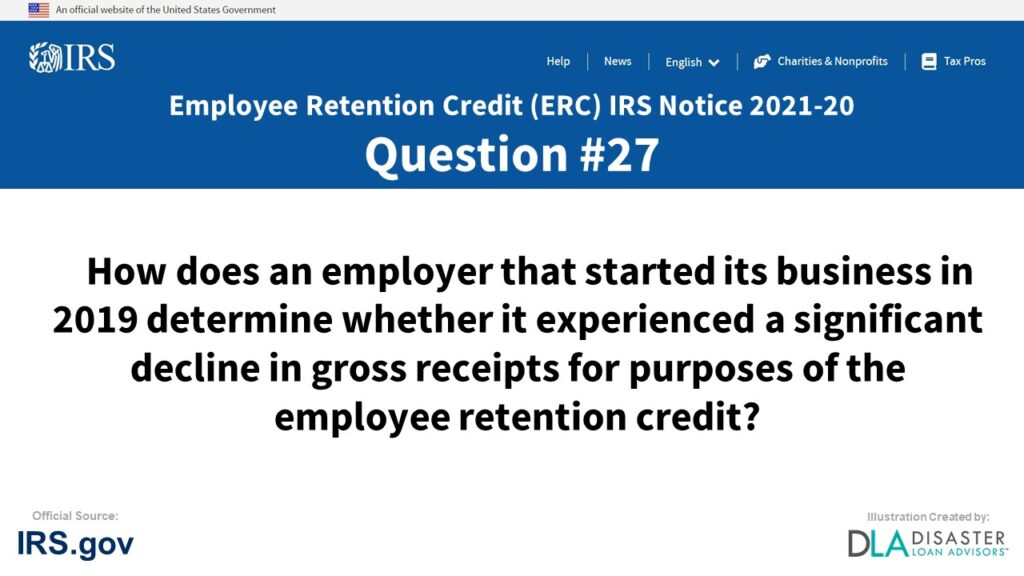
Question #27:
How does an employer that started its business in 2019 determine whether it experienced a significant decline in gross receipts for purposes of the employee retention credit?
Found under the E. Significant Decline in Gross Receipts section of the Employee Retention Credit (ERC) IRS Notice 2021-20 with updated guidance to help business owners follow the current ERC rules.
The answer to question #27, How does an employer that started its business in 2019 determine whether it experienced a significant decline in gross receipts for purposes of the employee retention credit?, can be found below.
ERC IRS Notice 2021-20 Question #27:
E. Significant Decline in Gross Receipts
How does an employer that started its business in 2019 determine whether it experienced a significant decline in gross receipts for purposes of the employee retention credit?
An employer that started its business in the first quarter of 2019 should use the gross receipts for the applicable quarter of 2019, as described below, for comparison to the gross receipts for the same quarter in 2020 to determine whether it experienced a significant decline in gross receipts in any quarter of 2020.
An employer that started its business in the second quarter of 2019 should use that quarter as the base period to determine whether it experienced a significant decline in gross receipts for the first two quarters in 2020 and should use the third and fourth quarters of 2019 for comparison to the third and fourth quarters of 2020, respectively, to determine whether it experienced a significant decline in gross receipts for those quarters.
An employer that started its business in the third quarter of 2019 should use that quarter as the base period to determine whether it experienced a significant decline in gross receipts for the first three quarters in 2020 and should use the fourth quarter of 2019 for comparison to the fourth quarter of 2020 to determine whether it experienced a significant decline in gross receipts for that quarter.
An employer that started its business in the fourth quarter of 2019 should use that quarter as the base period to determine whether it experienced a significant decline in gross receipts for any quarter in 2020.
If an employer commenced business in the middle of a quarter in 2019, the employer should estimate the gross receipts it would have had for the entire quarter based on the gross receipts for the portion of the quarter that the business was in operation. To calculate this amount, the employer may use any reasonable method, including extrapolating the gross receipts for the quarter based on the gross receipts for the number of days its business was operating during the quarter.
For more information about the Employee Retention Credit (ERC) IRS Notice 2021-20, visit the Internal Revenue Service (IRS) Department of the Treasury, official IRS.gov tax website.
Conclusion and Summary on How does an employer that started its business in 2019 determine whether it experienced a significant decline in gross receipts for purposes of the employee retention credit? – #27 ERC IRS Notice 2021-20
The answer to Question #27: “How does an employer that started its business in 2019 determine whether it experienced a significant decline in gross receipts for purposes of the employee retention credit?” was answered in detail above. It was found under section “E. Significant Decline in Gross Receipts” in IRS Notice 2021-20.
Leave a comment below if you have further questions on the Employee Retention Credit (ERC) or for clarifications on How does an employer that started its business in 2019 determine whether it experienced a significant decline in gross receipts for purposes of the employee retention credit?
Employee Retention Tax Credit (ERTC): Expert Assistance to Claim Your Business ERC Credit
Up to a $26,000 ERC Refund from the IRS for Each Employee
Disaster Loan Advisors can assist your business with the complex and confusing Employee Retention Credit (ERC), Form 941-X, and the Employee Retention Tax Credit (ERTC) program.
Depending on eligibility, business owners and companies can receive up to $26,000 per employee based on the number of W2 employees you had on the payroll in 2020 and 2021.
The ERC / ERTC Tax Credit Program is a valuable IRS tax credit you can claim. This is money you have already paid to the IRS in payroll taxes for your W2 employees.
We DO NOT charge a percentage (%) of your ERC Refund like some companies are charging. Some ERC firms out there are charging upwards of 15% to 35% of your ERC refund!
Our professional ERC fee and pricing structure is very reasonable in comparison.
If you are looking for an ERC Company that believes in providing professional ERC Services and value, in exchange for a fair, reasonable, and ethical fee for the amount of work required, Disaster Loan Advisors is a good fit for you.
Schedule Your Free Employee Retention Credit Consultation to see what amount of employee retention tax credit your company qualifies for.
Cover Image Credit: Irs.gov / IRS Notice 2021-20 / Disaster Loan Advisors.
